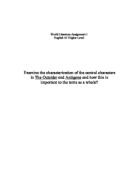Embodiment in the novel extends much deeper than a character simply symbolizing a theme, it allows characters to become destructive themes. Dr. Holmes becomes the embodiment of human nature. During his session with Dr. Holmes Septimus thinks of the doctor and human nature as “the brute with red nostrils” (93). The connotation of the word “brute” suggests that human nature is inherently evil. In fact Septimus, views human nature, and subsequently Dr. Holmes, as responsible for “the sin for which human nature had condemned him to death; that he did not feel” (91). What deepens the theme is the fact that Dr. Holmes is completely unaware of his embodiment. He even states that he has “come as a friend” right before Septimus kills himself (149). In actuality, his arrival triggered Septimus’s final downfall. The doctor’s inability to realize his own embodiment mirrors Septimus’s frustration with his own inability to feel, adding dimension to the theme. Similarly, Miss Kilman becomes the embodiment of love and religion. Even when “the body of Miss Kilman was not before her [Clarrisa], it overwhelmed her – the idea” (126). In this case, the embodiment is much more literal: the flesh of Miss Kilman becomes the theme. Miss Kilman, unlike Dr. Holmes, acknowledges the embodiment herself when she thinks, “it is the flesh that she must control” (128). Clarissa feels that love and religion destroy “privacy of the soul”, something she greatly values (127). On a more tangible level, Miss Kilman physically takes Elizabeth, who she greatly loves, away from Clarissa. The embodiment throughout the novel gives light to the destructive nature of certain themes. However, this embodiment would not be possible without free indirect discourse.
Free indirect discourse is the backbone that allows embodiment to flourish. The technique allows for the reader to enter Septimus’s mind to understand the gravity of the distress human nature causes him. He feels that “human nature, in short, was on him…Holmes was on him” (92). Switching to Rezia’s point of view, suddenly Dr. Holmes “only wanted to help them” (92). However, this thought contrasts greatly with the moment Rezia finally realizes Holmes causes some sort of distress in Septimus she tries to prevent him from seeing her husband right before Septimus kills himself. The novel is never told from Dr. Holmes’s point of view, which highlights Septimus’s lack of understanding in his inability to feel. Septimus spirals downhill when human literally encroaches on his brief moment of lucidity: Holmes entering his home. Clarissa sees love and religion as “the cruelest things in the world…clumsy, hot, domineering… [and] dressed in a mackintosh coat” (126). Through Clarissa’s thought, the reader is able to truly understand that Kilman has destroyed what Clarissa cherishes most. By switching to Miss Kilman’s narration the embodiment becomes much deeper. Kilman acknowledges that “she had got Elizabeth”, a fact that she knows Clarissa resents (129). Miss Kilman then tries “to think of something else” to bother Clarissa with, further highlighting the destructive nature of the embodiment (129). While Dr. Holmes’s oblivion to his embodiment strengthens it, Miss Kilman’s tactical awareness strengthens her embodiment. This major difference is made apparent only through narration, or in Holmes’s case, lack thereof. Without free indirect discourse, characters would not be able to embody themes.
Throughout the novel, theme becomes much more apparent through the technique of free indirect discourse. The characters of the novel come to embody, physically become, themes that reek havoc on other characters’ lives. Dr. Holmes and human nature push Septimus to his demise. Miss Kilman and love and religion manage to strip Clarissa of her true values. The narration style of the novel is essential to understanding the idea of embodiment. Undoubtedly, free indirect discourse in this novel highlights the deleterious nature of human nature and love and religion. The condemnation of the themes leads one to wonder, is this part of a larger social commentary that Woolf is attempting to make? Do aspects of human behavior inherently have perverse affects on humans themselves?








